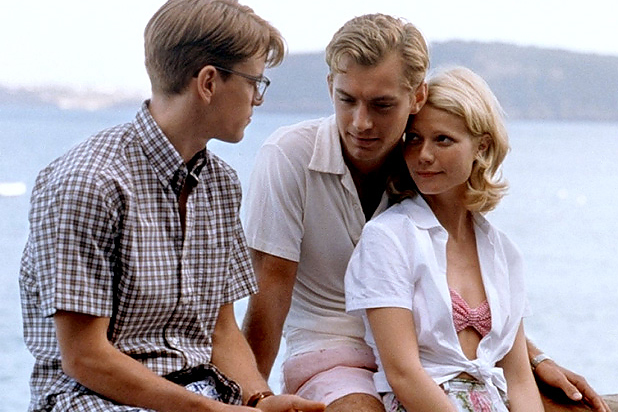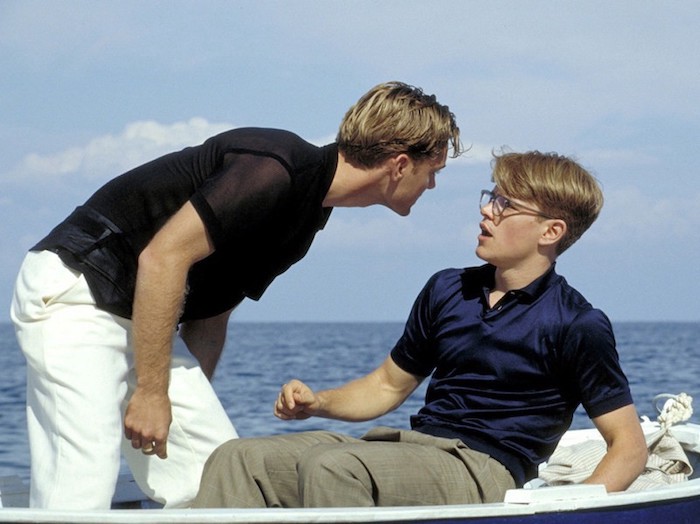In a film about forgery that’s been canonized by the fashion world, it’s only appropriate that The Talented Mr. Ripley opens with an outfit of false prestige. Matt Damon’s Tom Ripley first appears in a Princeton crest-emblazoned jacket, as he effortlessly mingles with high society and pretends to be the pianist to whom the jacket actually belongs. In Anthony Minghella’s identity theft thriller, which turns 20 this Christmas, that symbol of Ivy League breeding sets off a domino of sticky situations. First it beckons shipping magnate Herbert Greenleaf to Tom, leading him to hire the young man to retrieve his flighty son and fellow Princetonian, Dickie (Jude Law), from his life of Italian leisure. Tom agrees, puts on his trademark corduroy blazer, and sets off for the fictional coastal town of Mongibello, looking like the stuffiest American fish out of water. The beautifully sun-kissed Dickie and his fellow golden-haired beauty of a girlfriend, Marge Sherwood (Gwyneth Paltrow), on the other hand, spend their entire screen time looking like they’ve stepped right off the runway for a Resort collection.
No film inspires vacation envy quite like The Talented Mr. Ripley, with its effortlessly bourgeois execution of summer style. Everyone knows wearing clothes in the heat is very much an expectations-versus-reality situation—by the time you step out the door, every garment ends up being completely soaked with sweat. Dickie and Marge belong in the class of people whose clothing always looks good, even against climatic odds—somehow even in a suit. A dress shirt billows romantically in the seaside breeze; the right amount of buttons are undone, then tied in a knot that’s neither too tight nor too loose; everything is tailored to perfection and if tattered, then it looks adventurously storied, lovingly worn. Even Marge’s ponytail somehow maintains perfect, delicate croissant shape underneath a scarf.

Ripley isn’t just a movie with nice clothes as a result of its characters being wealthy. Clothing here is essential to the narrative. Costume designers Ann Roth and Gary Jones are the ones responsible for the thoughtful pieces picked out to signify class and taste. Tom dresses on a budget, almost in a uniform (blazer, shirt, glasses) while Dickie’s style is a personalized mix of high and low, of formal and casual—knitted polos with playfully patterned shorts, that kind of thing—often leaning towards the flamboyant by way of accessorizing (he is especially fond of hats and pinky rings).
Their stylistic differences are most playfully displayed in the murderous boating scene in which Tom is dressed in a plain black, possibly navy, polo and mousy-brown trousers while Dickie is in the elevated version of what is essentially the same outfit: a black shirt of similar cut but sheer, and crisp, white pants that can only be worn with extreme confidence. The film’s wardrobe also embodies class tourism: When Tom tries to become Dickie, his wardrobe errs on the side of gauche as he masquerades as the upper-class. This leads Dickie’s brash friend Freddie (Philip Seymour Hoffman) to take a jab at Tom’s imposter syndrome with: “The only thing that looks like Dickie is you.”
Dickie’s wardrobe also suggests someone with disposable income, but kept at a minimum, selectively picked for the living-out-of-a-suitcase lifestyle. He has his few favorite staples—of course, European custom-made. Even though we don’t see the full scope of his wardrobe, Gary Jones said in an interview, “We wanted to create a feeling that Dickie was someone who would look good in whatever he put on.” Though the stylists wanted to maintain an “old-fashioned aura,” re-watching this 20 years later, some pieces are actually unsurprisingly en vogue, due to fashion’s constant recycling. See: Dickie’s green sweater that would make anyone, erm, green with envy; his Gucci loafers, which, to be fair, never go out of style; meanwhile, Marge leans heavily into bandeaus and headbands (what’s more trendy right now than headbands?).

Meanwhile, Cate Blanchett, who plays American socialite Meredith Logue, makes her own case for the film’s best-dressed, with fuzzy berets and cinched-waist peacoats. In her fur number, she looks like the younger version of the iconic character she’d come to play in yet another adaptation of a Patricia Highsmith novel (Carol, based on The Price of Salt, released three years before the book of the same name The Talented Mr. Ripley is based on). Meredith’s presence—elegant yet so nerve-wracking—in what was previously just a Tom-Dickie-Marge ménage à trois throws off Tom’s game, making him constantly cover new tracks as he buries evidence. But for a brief moment of deceitful bliss, Tom could throw on Dickie’s jacket and feel accepted without sweating through his clothes.
